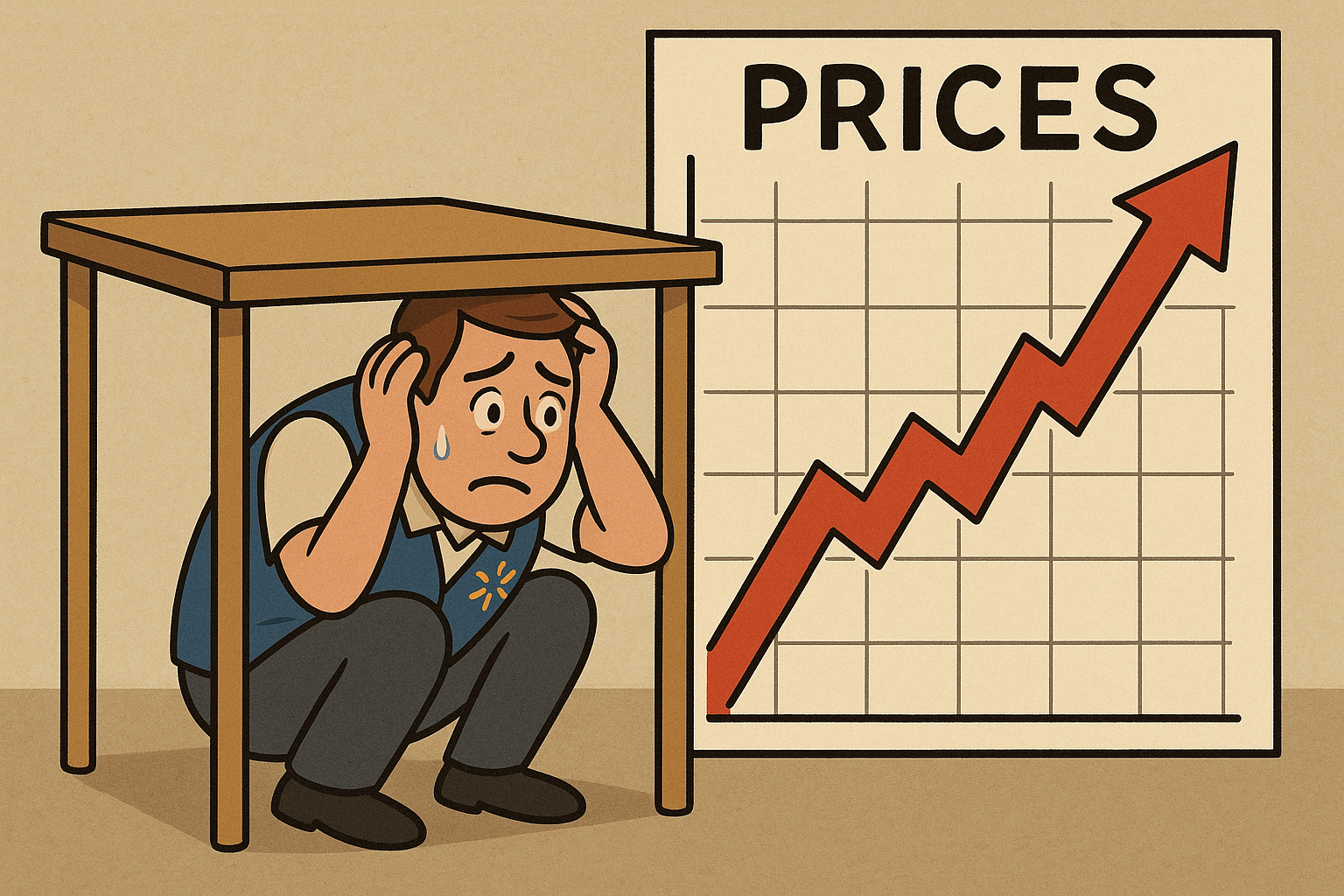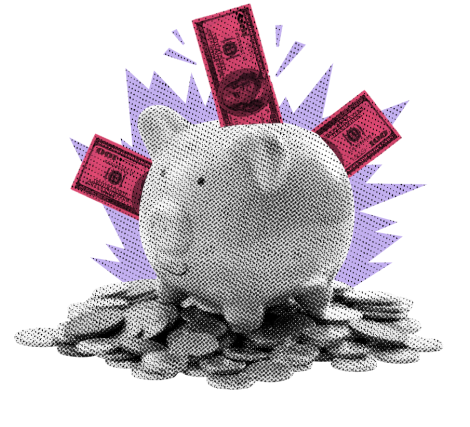
When Walmart raises prices due to tariffs, you know it’s getting real.
KEY TAKEAWAYS
- Walmart confirmed that prices are going up “by double digits,” and it’s because of tariffs.
- This is a clear sign that tariff-driven inflation is real—and it’s not something the Fed can easily fix.
- Inflation expectations are also on the rise, which is especially dangerous because those expectations often drive further inflation.
- Fed Chair Jerome Powell acknowledged that inflation will likely be volatile for years, not months.
- Meanwhile, bond yields are climbing as investors demand higher returns to compensate for rising inflation.
MY HOT TAKES
- The market is too focused on interest rates while ignoring the real root cause of inflation: tariffs.
- The Fed is effectively powerless against this kind of supply-push inflation.
- Tariffs are quietly fueling a long-term inflation issue that can’t be solved with rate adjustments.
- Walmart’s CFO interview said more than the official earnings call ever could—and that honesty helped clarify what’s really going on.
- What we could be seeing now is the start of an inflation spiral, and it’s being fueled by shifting expectations, not monetary policy.
- You can quote me: “When the poster child for low prices says prices are going higher, you should pay attention.”
The answers are there; you just have to listen. Are you one of those people that is obsessed with interest rates? It is very much en vogue these days, so if you are, I forgive you, let’s chat about it for a bit. But first, I want to divert for a moment because this is kind of important.
Yesterday, Walmart announced its Q1 earnings beating EPS estimates by 5.27% with a slight Revenue miss of -0.25%. All in all, it was a relatively solid announcement. However, what the world was most interested in even more than its performance or even future guidance was what impacts would the President’s tariff barrage have on the titanic retailer who is known to take advantage of cheaply produced imports. The earnings call was rather benign with messaging that tariffs could be a challenge, but the company was well-positioned to weather them.
For me, the interesting bit of news came in an interview the company’s CFO had with my sometimes co-host Madison Mills and Executive Editor Brian Sozzi at Yahoo Finance TV. As they typically do, they got the answers everyone wanted. Prices are going up soon, “by double digits”, directly resulting from tariffs. The company nor its suppliers can afford to eat the increased costs–they simply have no choice. Now, I know that should not surprise you, but for some reason, and I am not sure why, I get this feeling that this ugly reality has been getting buried in the recently volatile news cycle which has been dense with soundbites, tweets, and handshake agreements.
My friends, tariffs cause prices to rise, plain and simple. Plain and simple! Got it? I am happy that progress is being made in negotiations, but the plain fact, as I asserted a few days back, is that tariffs are still in effect, and promised ones that aren’t, are only on a 90-day temporary stay.
Now, someone in the biz whom I respect very much made a boorish statement yesterday afternoon, something to the effect that if Walmart talked to Mills and Sozzi, they must be desperate to get the message out. Of course, Walmart is desperate, but it took great reporting from Mady and Brian to get the message out loud and clear–just like they always do. Get familiar with them if you want real facts.
Ok, let’s get back to interest rates now that Walmart, the poster child for low priced retail, has said that prices are going up because of tariffs, we see more clearly the challenge faced by the Fed. Unless the administration comes out and says, “on tariffs, never mind, we were just kidding,” and of course they won’t, prices of stuff made anywhere other than the US are going to go up.
Will it be a one-time increase? Yes, but that increase will show up in the inflation figure for an entire year, and worse yet, it could cause general inflation to rise beyond, as inflation expectations get unanchored and rise. Yes, inflation can cause more inflation. That is a big problem for the Fed, because it is very difficult to fix without using a heavy hand.
Well, it turns out that inflation expectations are on the rise. This morning’s University of Michigan sentiment will give us a read of that. It is not necessarily what (the actual number) respondents are expecting, but rather that those expectations are rising. When consumers expect inflation to increase, they require higher wages which increase company costs… which leads to further inflation. It’s a spiral. The New York Federal Reserve also reports on inflation expectations. Check out the following chart then follow me to the finish.

It should be clear from this chart of NY Fed’s Inflation Expectations, that they are on the climb, despite my obvious notation. Why is this a problem for the Fed? Because it usually takes a recession to reverse the spiral. In other words, simply leaving interest rates unchanged is likely to have little effect on this type of inflation.
Do you know what else interest rates have very little effect on? Supply-push inflation caused by things like… like… TARIFFS. Now, I am sure that the Fed is well aware of these facts which I just shared with you. Yesterday, right around the same time that Walmart CEO and CFO were delivering the company’s Q1 results, Fed Chairman Powell said in a speech that he expected inflation to be volatile over the next few years. Years! This simply means that the Fed will be very reticent to lower interest rates any time soon, despite the hopes and expectations of investors.
Unfortunately, it gets worse. Most folks these days are obsessed with Fed policy, but the Fed does not control longer-maturity yields. Yields on US Treasuries directly impact mortgage rates and many other consumer-based loans. Higher 10-year yields also mean higher borrowing costs for the Government which is trying to cut budgets. In case you missed it, 10-year Treasury Note yields have been rising. Why, well for one reason, when higher inflation is expected, bond buyers require higher yields to make up for inflation. And you know from the chart above ☝️ that those are probably working against the low rates now camp.
So, if it is interest rates and bond yields that are on your mind, can you now see what the root cause for all these challenges lies? I won’t say it, but I will leave you with something controversial. If the Fed suddenly heeled to the President’s wishes and lowered the Fed Funds rate, would it change the outcome of this chapter materially? Would it remove the damage caused by tariffs? I won’t answer that question, and you don’t have to either. I simply wanted to simply underscore the reality. I also want you to know that this is precisely why every Chief Investment Officer, Chief Financial Officer, Chief Executive Officer, or Hedge Fund Manager squirm in their seat when asked questions about interest rate policy. They know how to alleviate the pressure, they just can’t say. Yesterday, one broke from the pack and said it. Reporting was on point!
YESTERDAY’S MARKETS
Stocks had a mixed close yesterday as economic numbers supported recently-bullish moves. The Producer Price Index / PPI and Retail Sales both came in better than expected. The tech-heavy Nasdaq took a break after a bullish run. 10-year yields eased by 10 basis points but remain elevated.

NEXT UP
- Housing Starts (April) are expected to have increased by 3.0% after falling by -11.4% in March, while Building Permits are expected to have slipped by -1.2% following a prior-month gain of 0.5%.
- University of Michigan Sentiment (May) may have climbed to 53.5 from 52.2. Inflation expectations were probably unchanged. This can be a market mover today.
- Fed speakers include Daly and Barr.
- Next week: still some important earnings announcements, Leading Economic Index, regional Fed reports, flash PMIs, and more housing numbers. Check back in on Monday to get your calendars and set your game plan for the week.
.png)

